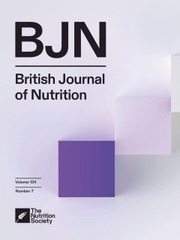Crossref Citations
This article has been cited by the following publications. This list is generated based on data provided by
Crossref.
El-Khoury, Antoine E
Sánchez, Melchor
Fukagawa, Naomi K
Gleason, Ray E
and
Young, Vernon R
1994.
Similar 24-h Pattern and Rate of Carbon Dioxide Production, by Indirect Calorimetry vs. Stable Isotope Dilution, in Healthy Adults under Standardized Metabolic Conditions.
The Journal of Nutrition,
Vol. 124,
Issue. 9,
p.
1615.
Vigus, Jane
Tata, Philip
Judd, Pat
Bowyert, Carole
and
Evans, Elizabeth
1995.
Which way to treat obesity? Emotional, eating and behavioural issues in dieting.
Journal of Human Nutrition and Dietetics,
Vol. 8,
Issue. 2,
p.
105.
Verboeket-van de Venne, W P
Westerterp, K R
van Hoek, B
and
Swart, G R
1995.
Energy expenditure and substrate metabolism in patients with cirrhosis of the liver: effects of the pattern of food intake..
Gut,
Vol. 36,
Issue. 1,
p.
110.
Spurr, GB
Dufour, DL
and
Reina, JC
1996.
Energy expenditure of urban Colombian women: a comparison of patterns and total daily expenditure by the heart rate and factorial methods.
The American Journal of Clinical Nutrition,
Vol. 63,
Issue. 6,
p.
870.
Verboeket-van de Venne, Wilhelmine P.H.G.
Westerterp, Klaas R.
Hermans-Limpens, Tanja J.F.M.B.
de Graaf, Cees
van het Hof, Karin H.
and
Weststrate, Jan A.
1996.
Long-term effects of consumption of full-fat or reduced-fat products in healthy non-obese volunteers: Assessment of energy expenditure and substrate oxidation.
Metabolism,
Vol. 45,
Issue. 8,
p.
1004.
Mela, David J.
1996.
Eating behaviour, food preferences and dietary intake in relation to obesity and body-weight status.
Proceedings of the Nutrition Society,
Vol. 55,
Issue. 3,
p.
803.
Bellisle, France
McDevitt, Regina
and
Prentice, Andrew M.
1997.
Meal frequency and energy balance.
British Journal of Nutrition,
Vol. 77,
Issue. S1,
p.
S57.
SPURR, G. B.
DUFOUR, DARNA L.
REINA, JULIO C.
and
HAUGHT, TANYA A.
1997.
Daily energy expenditure of women by factorial and heart rate methods.
Medicine & Science in Sports & Exercise,
Vol. 29,
Issue. 9,
p.
1255.
Westerterp-Plantenga, Margriet S.
Westerterp, Klaas R.
Rubbens, Mira
Verwegen, Christianne R. T.
Richelet, Jean-Paul
and
Gardette, Bernard
1999.
Appetite at “high altitude” [Operation Everest III (Comex-’97)]: a simulated ascent of Mount Everest.
Journal of Applied Physiology,
Vol. 87,
Issue. 1,
p.
391.
Johnstone, A. M.
Shannon, E.
Whybrow, S.
Reid, C. A.
and
Stubbs, R. J.
2000.
Altering the temporal distribution of energy intake with isoenergetically dense foods given as snacks does not affect total daily energy intake in normal-weight men.
British Journal of Nutrition,
Vol. 83,
Issue. 1,
p.
7.
Taylor, MA
and
Garrow, JS
2001.
Compared with nibbling, neither gorging nor a morning fast affect short-term energy balance in obese patients in a chamber calorimeter.
International Journal of Obesity,
Vol. 25,
Issue. 4,
p.
519.
Westerterp-Plantenga, MS
Kovacs, EMR
and
Melanson, KJ
2002.
Habitual meal frequency and energy intake regulation in partially temporally isolated men.
International Journal of Obesity,
Vol. 26,
Issue. 1,
p.
102.
McMurray, Robert
2002.
Nutritional Assessment of Athletes.
p.
203.
Grant, Mary Jo C.
Huether, Sue E.
and
Witte, Madolin K.
2003.
Effect of red blood cell transfusion on oxygen consumption in the anemic pediatric patient.
Pediatric Critical Care Medicine,
Vol. 4,
Issue. 4,
p.
459.
Westerterp, Klaas R.
2003.
Impacts of vigorous and non-vigorous activity on daily energy expenditure.
Proceedings of the Nutrition Society,
Vol. 62,
Issue. 3,
p.
645.
Westerterp, Klaas R.
and
Kester, Arnold D.M.
2003.
Physical Activity in Confined Conditions as an Indicator of Free‐Living Physical Activity.
Obesity Research,
Vol. 11,
Issue. 7,
p.
865.
Westerterp-Plantenga, Margriet S.
Goris, Annelies H. C.
Meijer, Erwin P.
and
Westerterp, Klaas R.
2003.
Habitual meal frequency in relation to resting and activity-induced energy expenditure in human subjects: the role of fat-free mass.
British Journal of Nutrition,
Vol. 90,
Issue. 3,
p.
643.
Farshchi, H R
Taylor, M A
and
Macdonald, I A
2004.
Decreased thermic effect of food after an irregular compared with a regular meal pattern in healthy lean women.
International Journal of Obesity,
Vol. 28,
Issue. 5,
p.
653.
Jebb, Susan A.
2005.
Dietary strategies for the prevention of obesity.
Proceedings of the Nutrition Society,
Vol. 64,
Issue. 2,
p.
217.
Farshchi, Hamid R
Taylor, Moira A
and
Macdonald, Ian A
2005.
Beneficial metabolic effects of regular meal frequency on dietary thermogenesis, insulin sensitivity, and fasting lipid profiles in healthy obese women1–3.
The American Journal of Clinical Nutrition,
Vol. 81,
Issue. 1,
p.
16.


